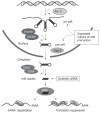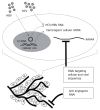Harnessing the RNA interference pathway to advance treatment and prevention of hepatocellular carcinoma
- PMID: 18350598
- PMCID: PMC2695907
- DOI: 10.3748/wjg.14.1670
Harnessing the RNA interference pathway to advance treatment and prevention of hepatocellular carcinoma
Abstract
Primary liver cancer is the fifth most common malignancy in the world and is a leading cause of cancer-related mortality. Available treatment for hepatocellular carcinoma (HCC), the commonest primary liver cancer, is rarely curative and there is a need to develop therapy that is more effective. Specific and powerful gene silencing that can be achieved by activating RNA interference (RNAi) has generated enthusiasm for exploiting this pathway for HCC therapy. Many studies have been carried out with the aim of silencing HCC-related cellular oncogenes or the hepatocarcinogenic hepatitis B virus (HBV) and hepatitis C virus (HCV). Proof of principle studies have demonstrated promising results, and an early clinical trial assessing RNAi-based HBV therapy is currently in progress. Although the data augur well, there are several significant hurdles that need to be overcome before the goal of RNAi-based therapy for HCC is realized. Particularly important are the efficient and safe delivery of RNAi effecters to target malignant tissue and the limitation of unintended harmful non-specific effects.
Figures


References
-
- El-Serag HB, Rudolph KL. Hepatocellular carcinoma: epidemiology and molecular carcinogenesis. Gastroenterology. 2007;132:2557–2576. - PubMed
-
- Parkin DM. Global cancer statistics in the year 2000. Lancet Oncol. 2001;2:533–543. - PubMed
-
- Chisari FV, Ferrari C. Hepatitis B virus immunopathogenesis. Annu Rev Immunol. 1995;13:29–60. - PubMed
Publication types
MeSH terms
Substances
LinkOut - more resources
Full Text Sources
Medical

